Children of her type contrive the purest philosophies. Ada had worked out her own little system. Hardly a week had elapsed since Van’s arrival when he was found worthy of being initiated in her web of wisdom. An individual’s life consisted of certain classified things: real things” which were unfrequent and priceless, simply “things” which formed the routine stuff of life; and “ghost things,” also called “fogs,” such as fever, toothache, dreadful disappointments, and death. Three or more things occurring at the same time formed a “tower,” or, if they came in immediate succession, they made a “bridge.” “Real towers” and “real bridges” were the joys of life, and when the towers came in a series, one experienced supreme rapture; it almost never happened, though. In some circumstances, in a certain light, a neutral “thing” might look or even actually become “real” or else, conversely, it might coagulate into a fetid “fog.” When the joy and the joyless happened to be intermixed, simultaneously or along the ramp of duration, one was confronted with “ruined towers” and “broken bridges.”
– Vladimir Nabokov, Ada or Ardor: A Family Chronicle
Shape: The Patterns that Connect
Abstractions are patterns that are there and not there at the same time. Take drawings of mine as examples
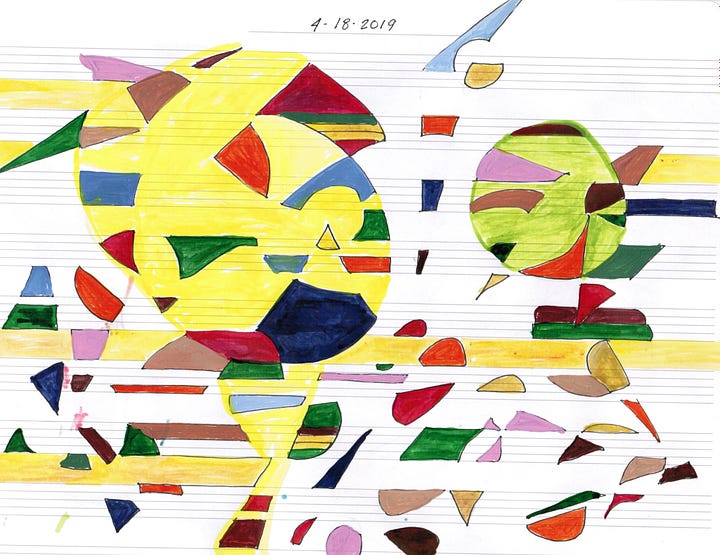
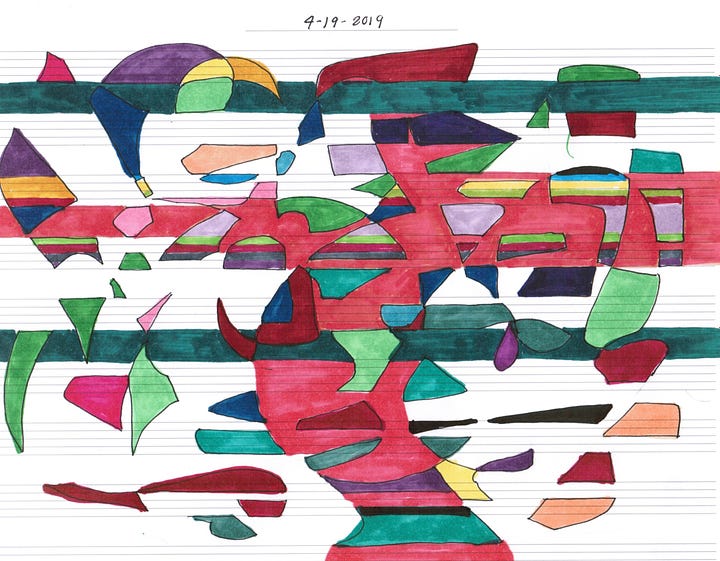
They are composed by simple “rules” ---
1. Draw geometric shapes over the ruled music lines
2. Trace interesting shapes made by intersections of lines
3. Color those shapes
4. Create “rivers of color” along the scale lines by following the contours of the original shapes
5. Erase the original lines
Here is another illustration. Can you see what is not there?
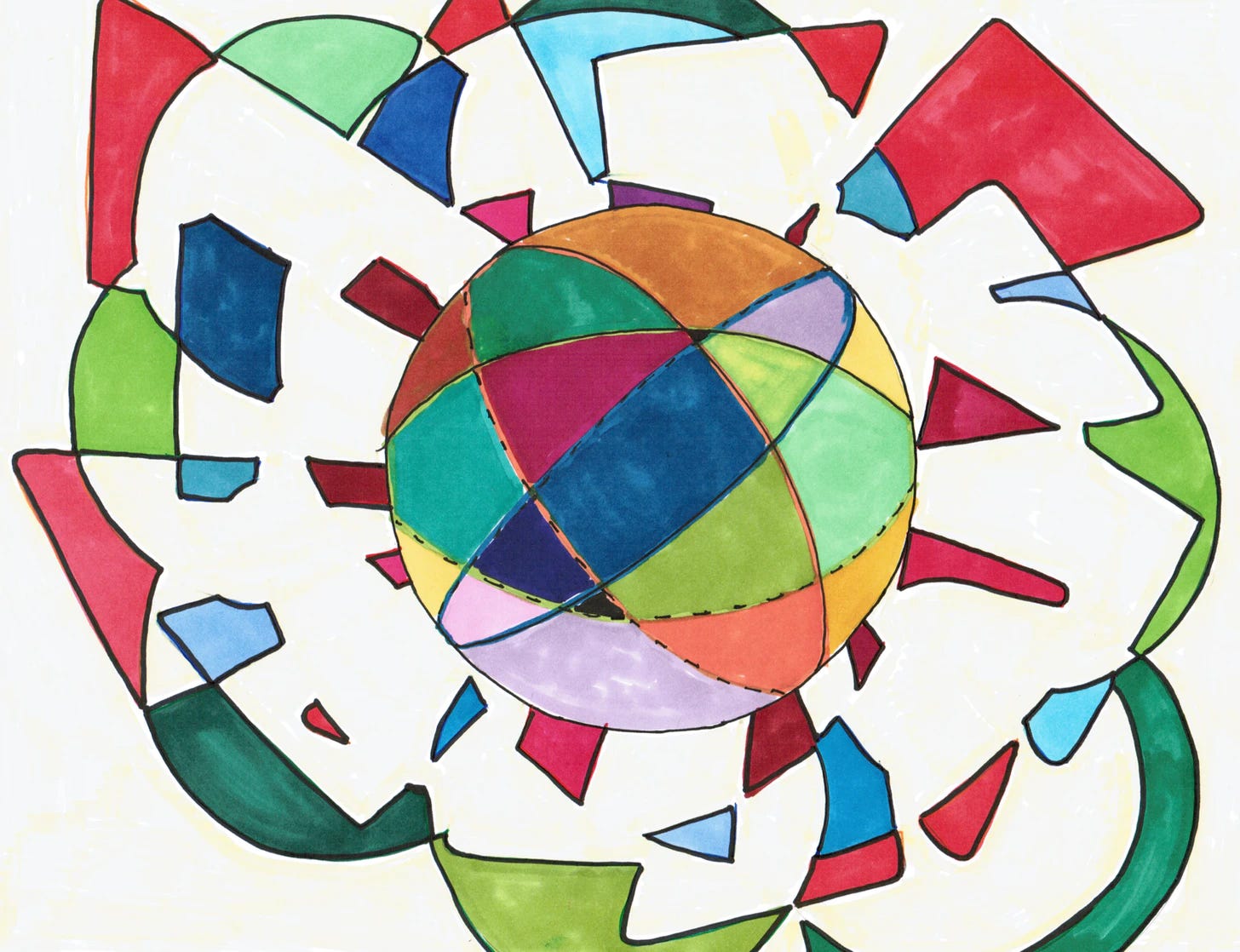
We can also think of “simple rules” as “patterns that connect.” Think of how a triangle is like a circle in some respect. The 6 trigonometry equations are answers to this question.
There are many beautiful visualizations of these kind of geometrical functions. Here is another one
The following shows how the Fibonacci sequence is related to nested rectangles and squares. Can you see what the rules are for nesting?
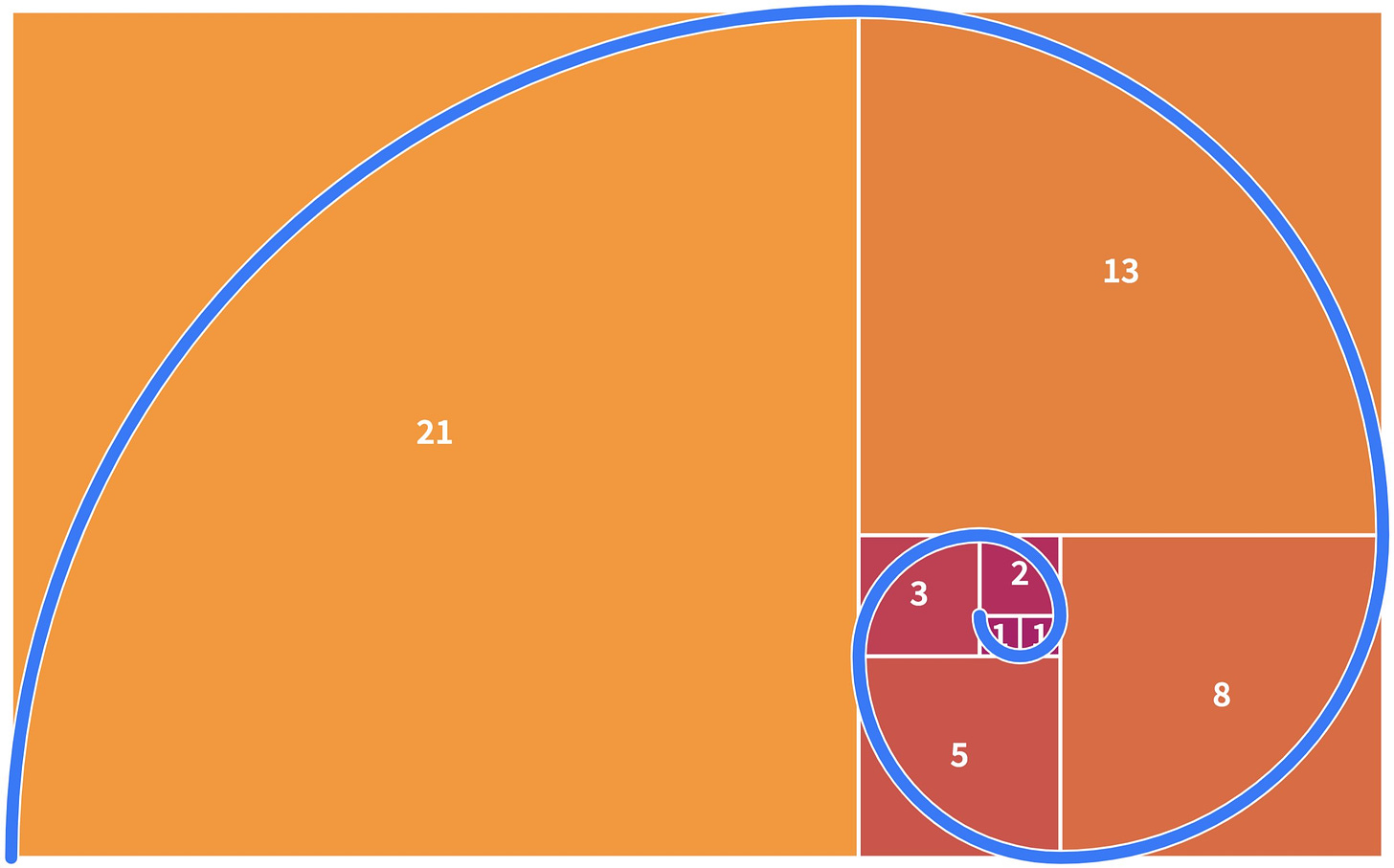
Fibonacci’s also arise from nesting circles:
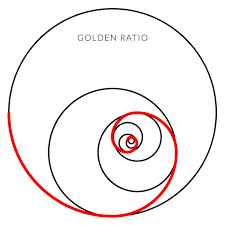
There are thousands, perhaps hundreds of thousands of Fibonacci art on the internet. Here is one I particularly like today
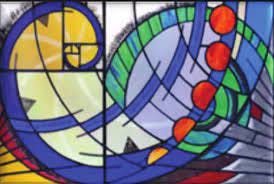
The artist/mathematician/polymath Robert Edward Grant drew this tesseract.
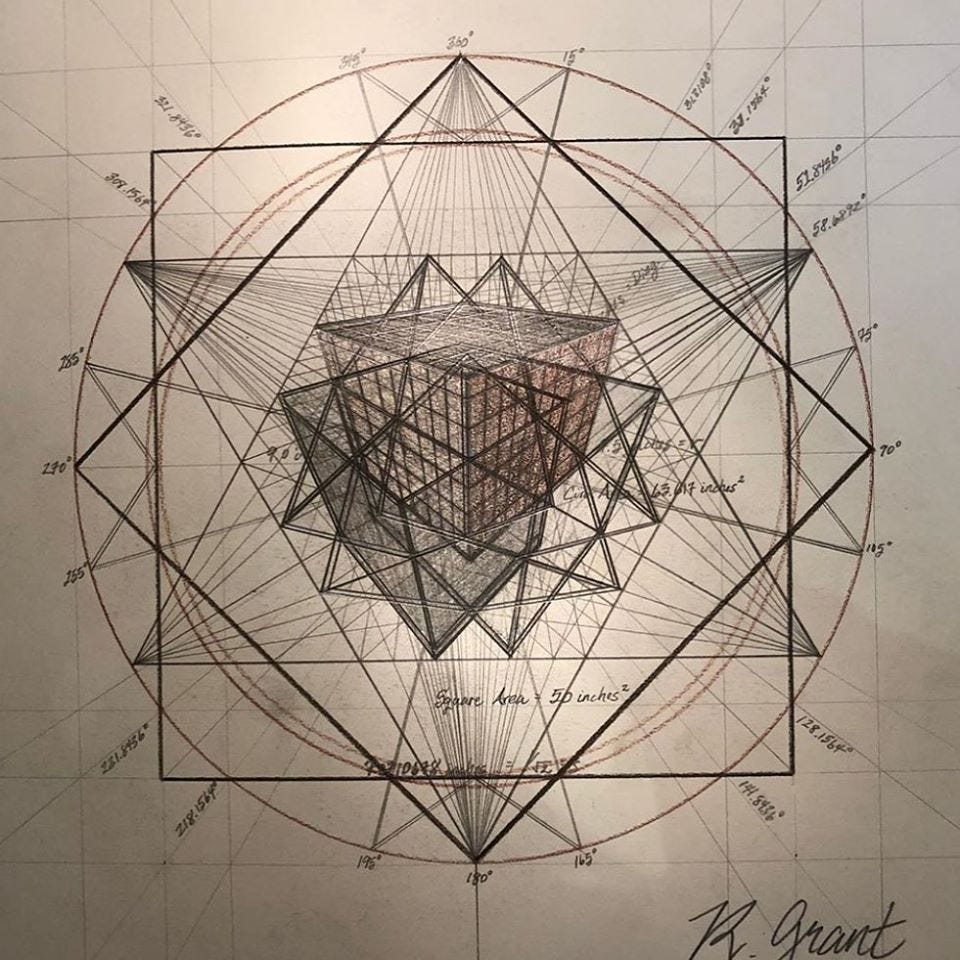
Shapes come from simple rules, which is the same as saying “rule-based processes.” The shapes may be real or abstract, appearing or invisible. When they are invisible, we intuit them by a felt-sense that there is an underlying pattern that connects. Together, the rules, the processes, and the patterns can be said to compose “a pattern language.”
The Nature of Order
The architect/polymath Christopher Alexander intuited a deep patterns that generated “more life” in both living and non-living things. His first work was explicating patterns that generated “living structure” in the built environment. This was his book “A Pattern Language.”
Alexander originally described this as a “language that was distilled from the practical expertise of building, whose elements are patterns. However, he cautions us, no pattern is an isolated entity. “Each pattern can exist in the world, only to the extent that is supported by other patterns: the larger patterns in which it is embedded, the patterns of the same size that surround it, and the smaller patterns which are embedded in it.”
This is a fundamental view of the world. It says that when you build a thing you cannot merely build that thing in isolation, but must also repair the world around it, and within it, so that the larger world at that one place becomes more coherent, and more whole, and the thing which you make takes its place in the web of nature, as you make it.
From the start, this was just the seed of what Alexander was up to, as he already had added metaphysical tones to the introduction, calling the book a “first step in the society-wide process by which people will gradually become conscious of their own pattern languages and work to improve them.” Alexander thought that the languages which govern people today are brutal and fragmented, and that most people have lost any true language to speak with at all. It was his goal to penetrate deep into the nature of things, to the core of all possible pattern languages, which can make people feel alive and human.
These metaphysical tones, of course, foreshadow his 4-volume opus, The Nature of Order. Alexander dedicated his life to helping people create living structure, based on a deep knowledge of the nature of order in the universe, of trying to articulate the living processes which can generate living structure. He contended that these living phenomenon are present in the structure not only of nature, but also in the built environment which had been constructed based on the same principles, and as such were accessible for anyone to see and feel. These structures, he said, had a quality without a name.
By the time he was writing the fourth and last book, The Luminous Ground, Alexander had come to relate to this quality as a “self-like” quality, an interiority that could guide him as he designed, planned, and constructed.
I first feel existence shimmering in reality, and I then feel it deep enough in the thing I am looking at and trying to make, to know it is worth capturing in concrete and wood and tile and paint. … This thing, this something, is not God, it is not nature, it is not feeling. It is some ultimate, beyond experience. When I reach for it, I try to find--- I can partly feel--- the illumination of existence, a glimpse of that ultimate. It is always the same thing at root. Yet, of course, it takes an infinite variety of different forms.
Alexander noticed that, in the presence of living structure, whether natural or man-made, something was released in him--- his true voice --- or he was released into something --- his natural state. At first he experienced this as getting closer and closer to his true self, but then he realized he was touching “something vast, existing outside of myself and inside myself, as if it were a contact with the eternal, something everlasting existing before me, in me, and around me.”
This is what I have felt on the beach on the north shore of Point Reyes, near San Francisco, when the sea comes crashing in with enormous force, when the water and wind are too loud for me to hear my voice, the waves too strong for me to think of swimming, the force of the water and the wind, the white foam of the waves, the blackish green moving water, the huge, loud grinding swells, the beach sand that goes on forever, the seaweeds strewn on the beach that have been hurled by a force greater than they are--- as I am, also, when I walk among them.
Yet, even though I am next to nothing in the presence of all this forces, I am free there. In such a place, at such a moment, I am crushed to understand my own smallness, and then understand the immensity of what exists. But this immensity of what exists--- and my connection to it--- is not only something in my heart. It is a vastness which is outside me and beyond me and inside of me.
Eventually, at the end of the book, Alexander has abstracted these experiences down to a metaphysics of the structure of matter-space as a field of living centers where “We … you … I … are instances of the field of centers or--- if we like to see it more deeply--- instances of the self-stuff of the universe, making its way, cumbersomely, from the trap of matter to the light of day.
Note
In this universe, the human self, yours and mine, are indistinguishable, in their substance, from the space and matter where the play of forms occurs.
In this instance, I hope you can see that what I am calling pure abstraction, is neither hyper-conceptualization, nor logical-rational, but what I am describing as the process of the mind directly entering the world. It is a process where perception is primary--- the perception of form in the objects, structure in the underlying processes, and pattern lying deeper within. Pure abstraction turns on perception, by increasing perceptual depth into the world. It is something, Alexander notes, “like a religious obligation, to allow this self to reveal itself. … It arises as a supreme obligation, which is our obligation to the matter/spirit we ourselves are made of.
But, he emphasizes, it arises now, “not as a religious or superstitious belief, but as a result of anew understanding of the structure of the universe.” And that understanding, I hold, is a direct realization, a seeing through the looking glass, all the way down to the level of pure abstraction.1
Music Math
One of the most fascinating areas of abstraction, is how musicians find math in music, and mathematicians see music in the equations. Here is an animated version of how music can reveal the rhythmic patterns of the prime numbers:
Here is a musical representation of the Fibonacci Sequence
And here is a video showing how music is related to geometric shape
And of course, we all know how different frequencies can create mandala-like shapes. Here are some particularly spectacular ones:
This video, although it’s really a cheeky advertisement, shows us why the Indian, Tibetan and other eastern traditions, developed harmonic chants (like OM) to create a holographic resonance in the body, mind, and space.
Meta-mathematics
Once we find hidden patterns in nature, and turn them into mathematical formulas, we can then start with the formulas, and use them to simulate hypothetical shapes, surfaces, and spaces. These excursions into theoretical mathematics, are themselves a kind of cross-modal imaginal operation on the very “field” that is math itself. The fascinating thing is that these simulated, hypothetical “speculative” mathematical realities, turn out to explicate actual realities that are otherwise hidden to us, without the new “mathematical language, that helps reveal them. This is true magik!
This is why I claim that math is the way the mind directly enters the world. It is, in a very literal sense, an organ of perception. We can work out the spatial relations and imaginary terrain of a torus (and other dimensional surfaces called Riemann surfaces or Lawson Surfaces) and that imaginary landscape is found to represent some parts of “physical” reality, whether those be processes in laminar flow, or vector-space forces in space-time.
Meta(mind)
Sometimes abstractions are created by the mind in order to represent itself as it grapples with the deepest questions of reality. Consider, for example, the long history of the development of the ancient Chinese Bagua used in Taoist cosmology to express the fundamental cosmological principles of reality. Here we can see that it expresses not 3rd-person objective principles, but the principles of the mind --- the metaphysical properties of thought itself. However, because the mind and reality are “twins,” the Bagua is useful as a sense-making analog across various disciplines. Use this link to take see of some of the earliest versions of the Bagua, as it evolved. (Note: you can zoom in on the board.)
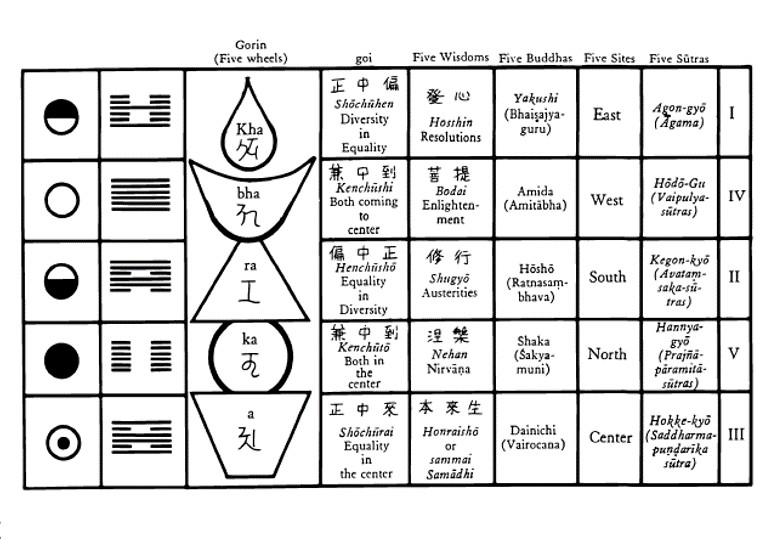
Mandala Mind
Finally, the very possibility of the mind’s working with geometric and abstract forms might be attributable to the fundamental global patterns that the mind assumes when the sensori-motor elements of experience--- sensation, perception, movement --- are suspended as in, for example, deep meditation states, hypnotic trance. Phenomena such as kaleidoscopic tetrads, intersecting vortices, and complex mandala-like theatres can spontaneously arise and display in awareness. These experiences are often also induced by dark-meditation retreats, or psychedelics. Once the psychological and social content of memory and imagination are quiesced, the “raw material” of the mind itself foregrounds into the spaces of awareness. These spaces can be point-like lights (0 D), slivers or rays of luminosity (2D), crystals or geometric shapes (3D) or blow up into a planetarium-like experience where one is surrounded by magical imagery that is laden with non-linguistic meaning (4 D). This later experience is considered 4 dimensional, because the planetarium-like surround constitutes both the spatial and temporal experience of being “in it” rather than of looking at it. Kasina meditations are specifically designed for these purposes. In other words, I am suggesting that our ordinary experience is constituted by 3 D space, and the temporal dimension that situates us “inside it” as experiential awareness, rather than as an outside observer. The fascinating shift that happens in Kasina meditation, for example, is that one is able to experience that which one is initially observing, wrapping around oneself into a larger reality that one belongs to, rather than is witness from afar. Here the boundary that separates is time, not space. For when one is witnessing the 3 D world from somewhere else, for example, observing the earth from the space station, one is situated in a different temporal dimension. One has stepped out of the temporal frame that is the pulse of the living earth, and into the temporal frame that is elsewhere. This I believe is what we mean by time being relative to travel in space. We are literally, transporting ourselves into and out of temporal frames which are felt psychologically, because they are real features of the universe. It is this sense in time also functions as Gibson’s perceptual array, a gradient-field that constitutes the causal manifold of universal relations. In short, what I am proposing is that the Kasina meditation experience of the shift from outside observer of 3 D objects, to inside inhabitant of that very same 3 D world, (the object-to-subject shift), while experienced as something that has to do with spatial dimensions, is in reality the shift between temporal realms. This is something Gebser intuited--- the primacy of temporics with respect to aperspectival consciousness.2 These kinds of experiences infer, affirm, or confirm --- i.e. validate to one degree or another --- that the original patterns are encoded by the underlying process-nature-intelligence of the universe, rather than merely stamped on our minds through the contingent evolution of our species on this planet, or the conditioned development of individuals. Rather there is a deep sense what is being revealed are the very same patterns-process-intelligence that underlies sentience, consciousness and awareness itself. The question of whether we can see dimensional patterns, like mandalas and fractals, because we live in a dimensional world, or whether we see the world as dimensional and fractal, because those are the properties that our mind draws upon to organize it--- this debate is no longer meaningful. Reality-pattern and mind-pattern are seen as isomorphic, twins, as it were, branched from the womb of source, and connected there still.
Action Protocols
In our New Theory of the Body, we are employing the core term of “action protocol” as a super-integrating concept. For example, we have the basic AP that goes from arousal » perception » actions that satisfy. I want to convince you of 3 things:
- That pure abstractions and math follow this basic AP
- That all mathematic operations are action protocols in their own right
- That all pure abstractions are action protocols in their own right
Consider, for example, the following: 1 + 1 = 2 We know that it is related to the activity of taking one thing and taking another thing together. It says that “2” means “take one thing and then take another thing, together.” That is one way to describe the action protocol of ”+”
Many mathematical operations are action protocols involving geometric shape. As we already discussed, math can reveal the hidden shape behind what appears. Math can also reveal the hidden relationships --- the mechanism, which may be a real or hypothetical mechanism. We can say the movement is such because it is “as if” it were constrained by an ellipse. The “ellipse may be a discrete physical thing, or it may be a particular force or field --- something more virtual, that is operating in a much more complex or subtle way. Consider for example, this video
If you observed something that behaved in this way, you could infer that there was a hidden “ellipse” effecting the behavior. The complexity you are seeing is actually a result of a simple constraint --- a simple rule. The complex patterns and movements of murmurations, are based on simple “rules.”
I think that you can see how the term “action protocol” covers the idea here, where simple rules (the protocols) “code” for complex patterns:
Here is another example.
We have already covered how rats can simulate their environments by running a maze several times, and then extracting the information into a map which shows them the shortest route. We also saw how rats can simulate hypothetical environments during REM sleep, wherein they combine parts of maze maps with parts of other maze maps, and learn how to run the hypothetical mazes. This explains how the rats accelerate their learning over time, because they anticipate possible mazes that the researcher may present to them.
Now watch this video on robotic mice and the evolution of their software (protocols) and hardware (action potentials).
At around the 16 minute mark, you see something new. The mice are not creating hypothetical paths, but are creating paths that are “pure abstractions” --- they are not constructed by the walls of the maze, but by the “insights” of the creator. In other words, the paths that the mice run, are “real” in the sense that they are “there” in the maze, but “virtual” in the sense that there is a process of “pure abstraction” that happens to reveal them. This is why I say that “pure abstractions” are the way that the mind directly enters the world. It means that the mind perceives what is actually there, but not there, actually. It is there potentially, depending upon the mind’s ability to virtualize its existence.
I can imagine a different maze than the one I am in. But that doesn’t help me solve the problem. But if I can intuit the deeper, virtual pattern of the maze that I am in, I have a direct insight into the nature of things. Intuition is the engine that produces pure abstractions. It is the mind’s direct entry into the world. It is, I believe the actual nature of mind, and the reason why minds are “virtual reality generators.”
This is where the realm of Magĩk-Realité, in which we enter the causal manifold of reality. This is why mathematicians have spiritual experiences around beautiful equations, like Euler’s Equation.
Think of the path around the circle in the same way we saw the virtual paths in the maze. These are paths that quantum particles follow --- but they are not constructed by any “thing” --- they are the virtual-real, the Magĩk-Realité of the universal life flow, source code, as it were. In terms of our model of Action Protocols & Habitat/Habitas, these virtual-real orders are pure protocols, pure habitas, and therefore, “pure interiority.” They are the way the universe is actually related--- not through external participation, but through a living-tissue-fabric of internal relations, the pure potential of what is not actually the case.
Now make the perspectival shift from thinking of paths in concrete terms, to life paths, or being on the spiritual path. Your own route is constrained by metaphors that function like the walls in the maze. And since most people are running the maze (the complexity of the world) using these walls as constraints, there is a big groove that humanity gets trapped into--- a kind of canalization which creates the Egregore.
Enlightenment is the ability to “see” the pure paths … maybe that’s why it’s called Pure Land Buddhism, which is associated with “Buddha-fields.”
Bonus Material - we might be playing with these in the live sessions. Do you see/feel the action protocols?
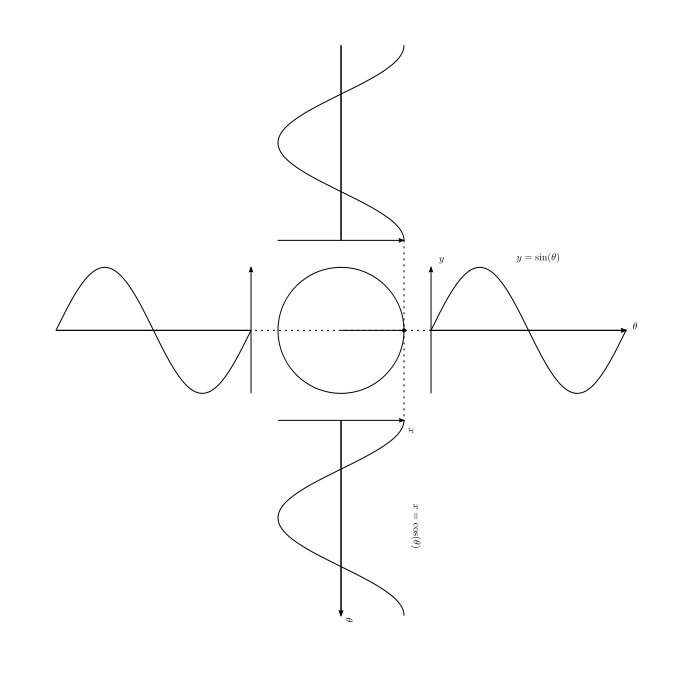
Further Resources
- Original Content Material
- Animation vs. Math
- Suddenly, while bike riding, it became very clear to me that mathematics are not invented, but discovered.
- Something Strange Happens When You Keep Squaring
Cohorts
Note that access requires a paid membership.
Footnotes
-
↩Armed with this view we can unite our personal intuition of religious awe with our sensible scientific understanding of the world. It becoms all one, it all makes sense together. Life and religion fall into place and fit together with physics as necessary consequences of the structure of the world--- that is, of the way that matter-space is made. ~ C. Alexander
-
A similar switch happens when one is looking at a movie on a screen (3 D) versus putting on virtual reality goggles and enters directly into the 3 D world. This is the danger of artificial reality, as once one relegates the 4th, temporal dimension, the last dimension left, to the machine, there is no “fourth wall” as it were, to remind us of the artificiality (and hence manipulative power) of the world that is created therein.
Similarly, and not coincidentally, there is a shift from a condition of having hallucination that seem to be “out-there” although one realizes they are projected from one’s own mind, and the condition of being “sucked into” the hallucination. Or the difference between a dream which is completely objectified out there, or inhabiting the dream-self inside the dream itself. Or: red pill vs blue pill. ↩